Introduction
In the rapidly evolving world of software development, the integration of DevOps has emerged as a pivotal strategy for organizations striving to enhance their operational efficiency and responsiveness. By bridging the gap between development and IT operations, DevOps fosters a culture of collaboration that not only accelerates the delivery of high-quality software but also addresses contemporary challenges such as security and observability.
As businesses increasingly adopt this methodology, understanding its core principles, tools, and the benefits it offers is essential for navigating the complexities of modern software development. This article delves into the foundational aspects of DevOps, explores its service offerings, and highlights the transformative potential it holds for organizations poised to thrive in a competitive landscape.
Defining DevOps: The Foundation of Modern Software Development
DevOps service offerings represent a strategic integration of software creation (Dev) and IT operations (Ops), specifically aimed at improving the speed and quality of software delivery. By fostering a strong culture of collaboration between creation and operations teams, organizations can significantly shorten the systems life cycle while ensuring the continuous delivery of high-quality software. This methodology fosters improved communication and integrates a variety of automated processes and tools to optimize workflows.
As Jigar Agrawal aptly noted,
This approach to software development is recognized as a leading method utilized globally in 2022 for its principles of communication, teamwork, integration, and automation.
Such an approach not only accelerates the delivery of software but also enhances its reliability, positioning this framework as essential for entities aiming to thrive in a competitive landscape. The rising adoption of DevOps service offerings is highlighted by an increasing acknowledgment of their significance in tackling modern challenges, including the need for integrated security and observability, as indicated by recent findings from Pulse 2023, which reveal that 72% of respondents are combining security with observability and monitoring to counter dynamic security threats.
Furthermore, the case study titled 'Challenges in Cloud Cost Management' highlights that despite the increasing adoption of development and operations practices, only 30% of organizations can accurately track their cloud spending, indicating a significant gap in cloud cost management and the need for improved visibility and control over cloud expenditures. Additionally, with the average age of an employed engineer in operations and development being 39 years old, understanding the demographic context can be crucial for CTOs considering consulting services in this area.
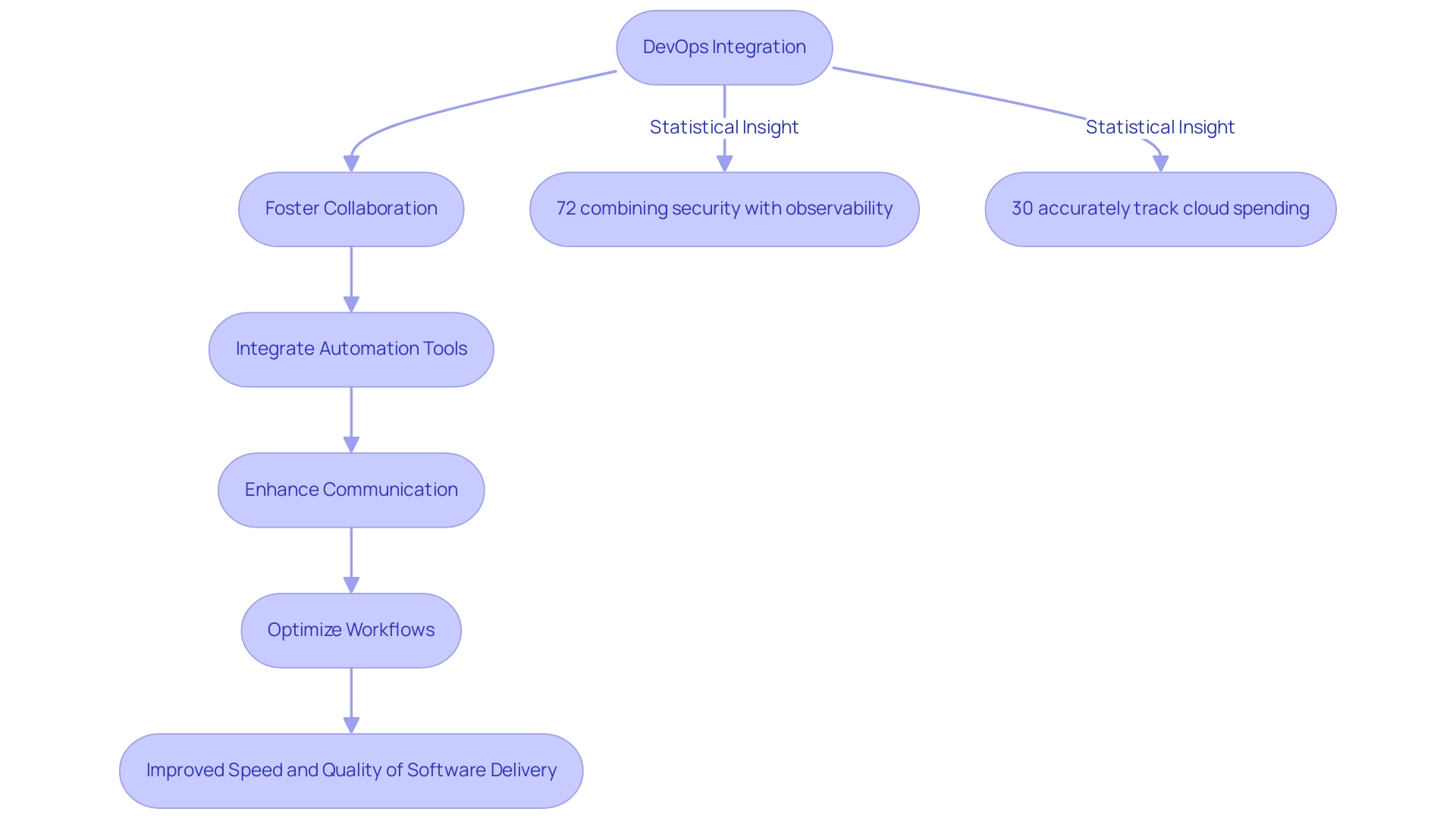
Exploring DevOps Service Offerings: Tools and Practices for Success
A comprehensive range of resources and practices specifically designed to enhance software development and deployment processes is included in DevOps service offerings. Key components include:
-
Continuous Integration and Continuous Deployment (CI/CD): Tools such as Jenkins, GitLab CI, and CircleCI play a pivotal role in automating the integration of code changes.
This automation allows for rapid deployment with minimal manual intervention, significantly reducing the time to market for new features and fixes. -
Configuration Management: Solutions like Ansible, Chef, and Puppet facilitate the management of infrastructure configurations, ensuring consistency across various environments.
Recent advancements in these resources have greatly improved their effectiveness in supporting automated deployments and scaling applications. -
Monitoring and Logging: Monitoring software such as Prometheus and Grafana, along with the ELK Stack, provide critical insights into system performance.
These tools enable proactive management of applications and infrastructure, ensuring that potential issues are identified and addressed before they impact users.
Adela Belin, a leading content marketer, emphasizes the value of centralized log collection, stating,Centralized log collection simplifies and accelerates security incident investigations and audit responses, enhancing security and compliance postures as a result.
-
Collaboration Platforms: Utilizing collaboration platforms such as Slack or Microsoft Teams enhances communication between development and operations teams.
This encourages a culture of collective responsibility, which is crucial for successful practices in development and operations. -
Market Demand and Case Studies: The need for skills in this area is shown in hiring speed statistics, which suggest that IT companies are increasingly looking for experts adept in these resources to fulfill their operational requirements.
A significant instance is Site24x7, a SaaS-based performance monitoring application that illustrates the efficient application of development and operations practices.
It allows individuals to observe different facets of their IT infrastructure while offering extensive monitoring functionalities, root cause examination, and AI/ML capabilities for anomaly identification.
By incorporating these resources into their processes, companies can greatly improve their capacity to provide software through DevOps service offerings consistently and effectively, in accordance with present industry requirements and anticipations.
It is crucial to recognize that most teams in this field employ various tools concurrently to tackle different phases of the lifecycle, ensuring a comprehensive approach to software creation and deployment.
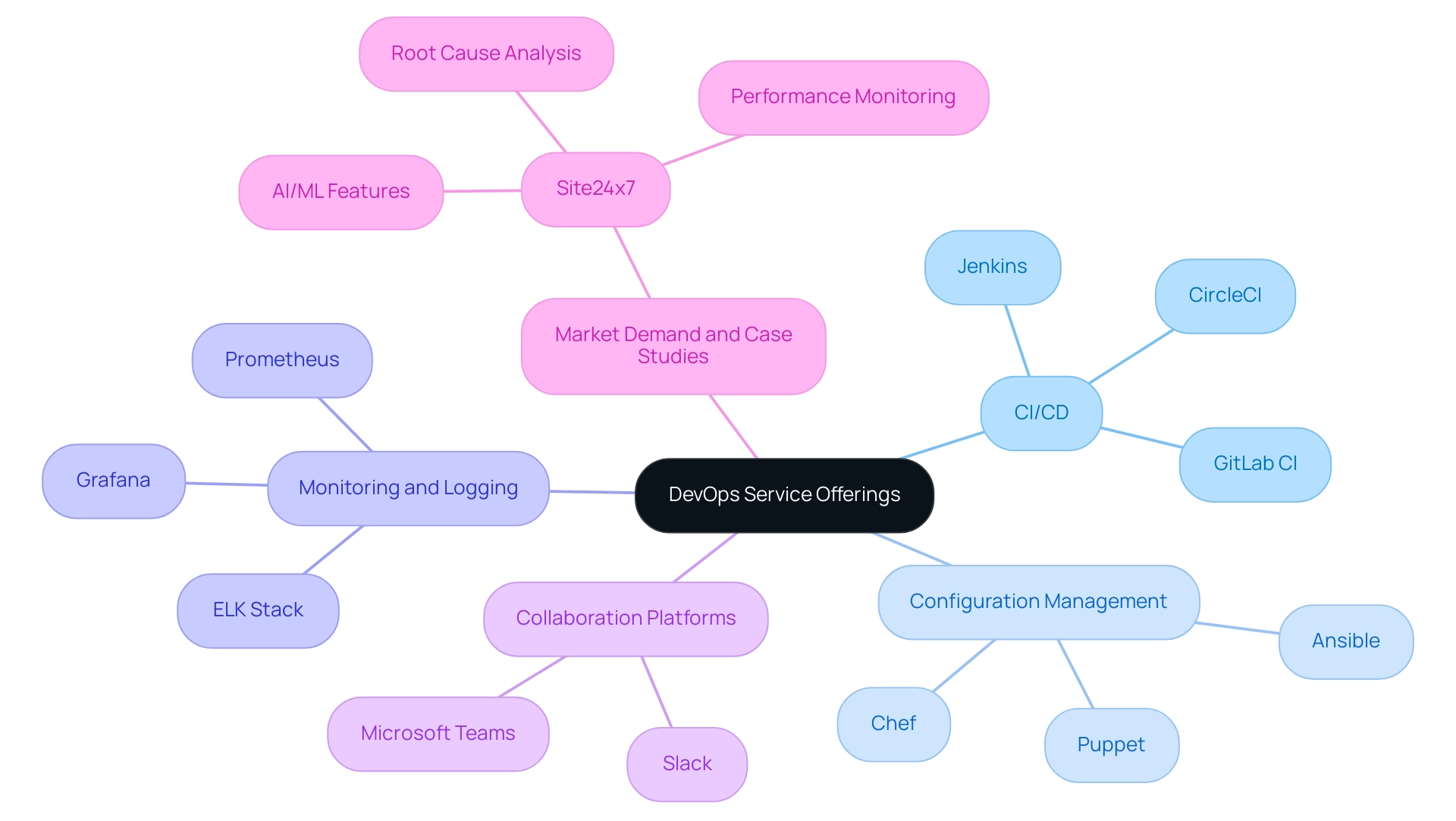
The Benefits of Adopting DevOps Services for Businesses
The adoption of devops service offerings presents numerous advantages for organizations that aim to enhance their operational effectiveness and competitiveness. These benefits include:
-
Accelerated Time-to-Market: The integration of development and deployment processes streamlines workflows, enabling businesses to roll out new features and updates swiftly. This responsiveness to market demands is essential in a fast-paced digital environment, with statistics showing that companies employing agile methodologies report significant reductions in time-to-market. Furthermore, research indicates that 71% of adopters also implement microservices and containers, further enhancing their agility and speed.
-
Fostering Enhanced Collaboration: The development operations framework cultivates a culture of collaboration among diverse teams, effectively dismantling silos and encouraging shared accountability for project outcomes. As noted by DORA, "Development and Operations specialists work across departments and teams," which underscores the importance of this collaborative approach. This not only boosts productivity but also aligns team goals with business objectives, as industry experts emphasize.
-
Optimized Efficiency: By automating repetitive tasks, the practice minimizes manual errors and allows teams to dedicate their efforts to higher-value initiatives. This optimization of resource utilization is particularly beneficial for entities looking to enhance their operational workflows.
-
Elevated Quality and Reliability: Continuous testing and monitoring within the development and operations lifecycle facilitate the early detection of issues, resulting in improved software quality and reduced downtime. This proactive approach to quality assurance is essential for maintaining business continuity and reliability in service delivery.
-
Increased Customer Satisfaction: With faster and more reliable software delivery, organizations can better align their offerings with customer needs, leading to heightened satisfaction and loyalty. As companies emphasize customer-focused strategies, the importance of devops service offerings in development and operations for delivering value becomes increasingly prominent.
The worldwide embrace of development and operations, particularly through devops service offerings, reflects a significant trend, with the market projected to reach $12.85 billion by 2025, more than double the revenue in 2018, highlighting the strategic importance of devops service offerings across various sectors—including non-profits, energy, and healthcare. Collectively, these advantages highlight the transformative potential of this approach to drive innovation and maintain a competitive edge in today's dynamic market landscape.
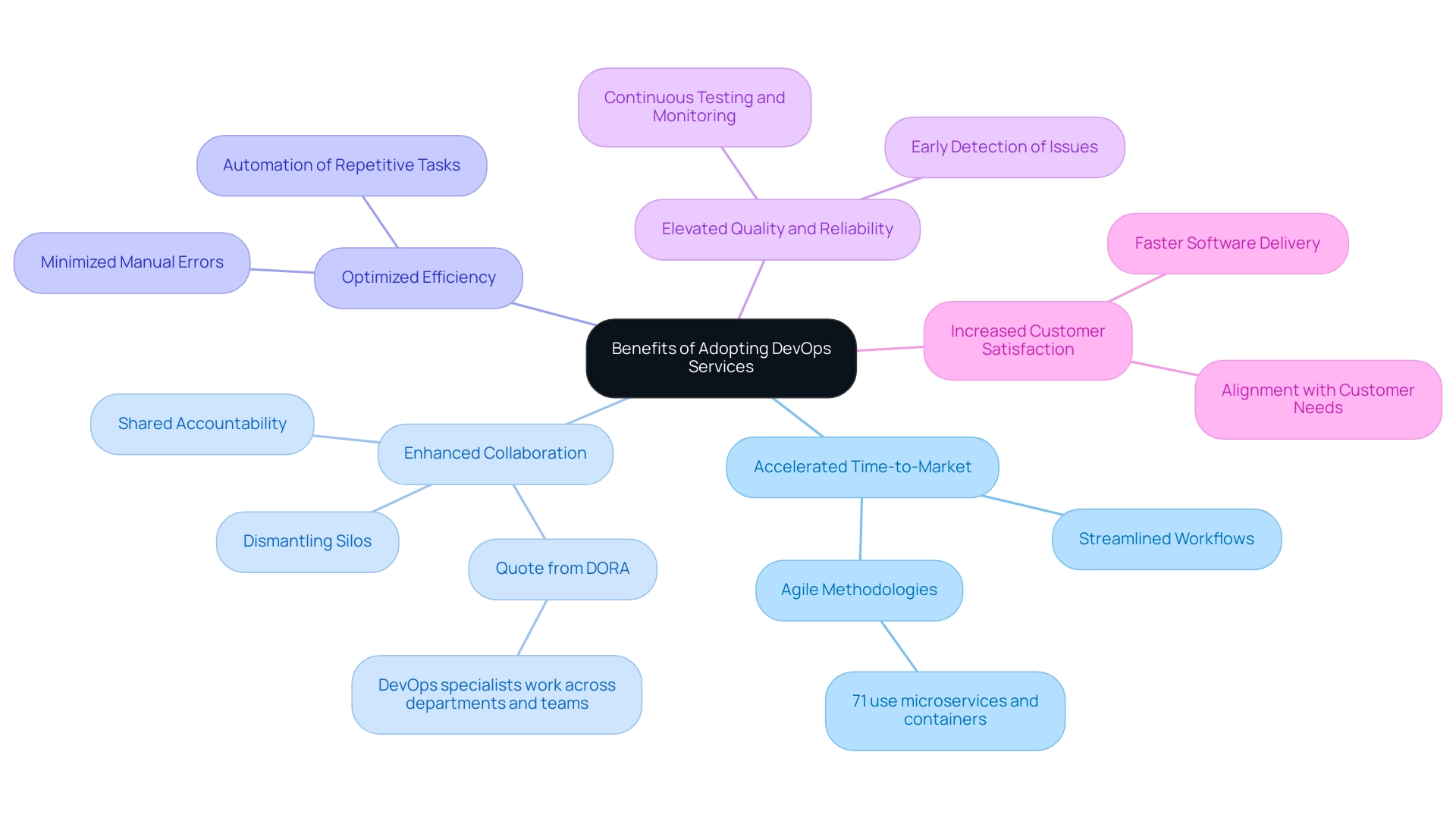
Navigating Challenges in Implementing DevOps Services
Introducing integrated development and operations solutions poses companies with several significant challenges that necessitate careful navigation:
- Cultural Resistance: Shifting to a development and operations approach requires a significant cultural transformation within the entity. Team members who are used to conventional workflows may resist this change, hindering the overall adoption of development and operations practices. Notably, organizations that promote robust development and operations cultures have reported a 20% decrease in employee turnover, highlighting the importance of overcoming cultural barriers. Trust is essential in every stage of the development and operations process, particularly within the devops service offerings, from planning to deployment, facilitating collaboration and encouraging team members to embrace new methodologies.
- Skill Gaps: A notable barrier is the possible deficiency of essential abilities among team members, which can impede the effective implementation of methodologies and resources. Ongoing education and professional growth initiatives are crucial to close these gaps and ensure teams are prepared to utilize devops service offerings effectively.
- Integration of Tools: The complexity of ensuring seamless integration among various development operations tools cannot be understated. This necessitates careful planning and configuration of devops service offerings to enable seamless operations and optimize the advantages of the development and operations methodology. The changing environment of software development practices, highlighted by trends like GitOps and NoOps, offers both challenges and chances that companies must navigate carefully.
- Measuring Success: Creating effective metrics to assess the success of development operations initiatives presents a challenge for numerous entities. Without clear benchmarks, assessing progress and making informed adjustments can be difficult, complicating the path to continuous improvement.
- Security Concerns: The fast-paced nature of development and operations can sometimes lead to security oversights, underscoring the necessity for integrated security practices throughout the lifecycle.
Addressing these challenges requires strategic planning, a commitment to continuous learning, and a collaborative culture that actively embraces change, which can be supported by devops service offerings. Insights from the case study titled 'Transformative Leadership Through DevOps Culture' emphasize the importance of continuous improvement in business through Agile methodologies, automation, and cloud computing, illustrating how organizations can effectively achieve their goals by adopting a culture of collaboration. As the environment of software development operations evolves—with trends such as GitOps, NoOps, and the integration of AI and machine learning—organizations must remain agile and responsive to these shifts to harness the full potential of this approach.
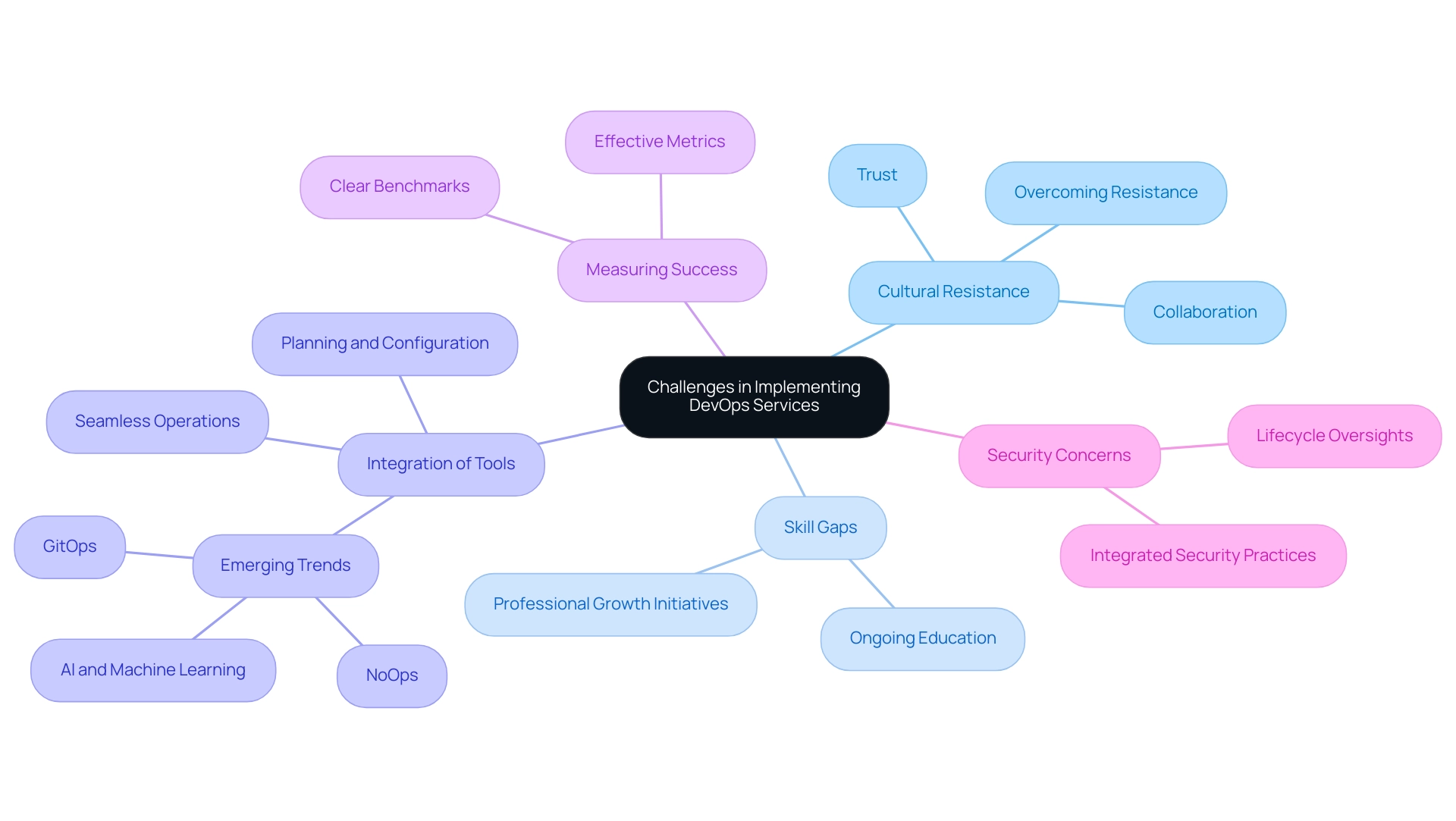
The Future of DevOps: Trends and Innovations to Watch
The landscape of software development and operations is undergoing significant transformation driven by key trends and innovations that are reshaping practices and strategies. Important developments to monitor include:
-
Artificial Intelligence and Machine Learning: The integration of AI and machine learning within software development operations is increasingly prevalent.
These technologies are providing advanced analytics and automation capabilities that enhance decision-making, accelerate testing processes, and improve operational efficiency. Implementing AI in testing is particularly crucial, as it enhances coverage, reduces false positives, and accelerates the testing process. A notable case in point is Microsoft's implementation of AI-driven code analysis, which markedly reduced the probability of data leaks and decreased security threats by 25% within a year. -
Infrastructure as Code (IAC): The adoption of Infrastructure as Code is on the rise, allowing organizations to manage infrastructure through code.
This approach enhances consistency across environments and significantly reduces provisioning times. Statistics indicate growing interest in IAC, with its adoption expected to rise as teams seek to increase automation and efficiency. -
DevSecOps: The increasing focus on security within the DevOps lifecycle is manifesting in the widespread adoption of DevSecOps practices.
This approach integrates security measures throughout the creation process, ensuring that security is a core component rather than an afterthought. -
Serverless Architectures: The advent of serverless computing is transforming application development.
This model allows developers to create and scale applications without the burden of managing the underlying infrastructure, streamlining operations and yielding cost savings. -
Microservices Architecture: The trend toward microservices continues to gain momentum, allowing entities to develop applications as a collection of small, independently deployable services.
This architectural style enhances flexibility and scalability, catering to the dynamic needs of modern business environments.
Additionally, the continuous integration tools market is currently valued at $1.4 billion and is expected to grow to $3.72 billion by 2029 at a CAGR of 21.18%.
Staying informed about these trends will empower organizations to proactively adapt their DevOps service offerings, leveraging emerging technologies to maintain a competitive edge. With over 1.3 million tech professionals expected to work in the software development industry by 2024, as noted by Ritvik Gupta, understanding these advancements becomes imperative for future success.
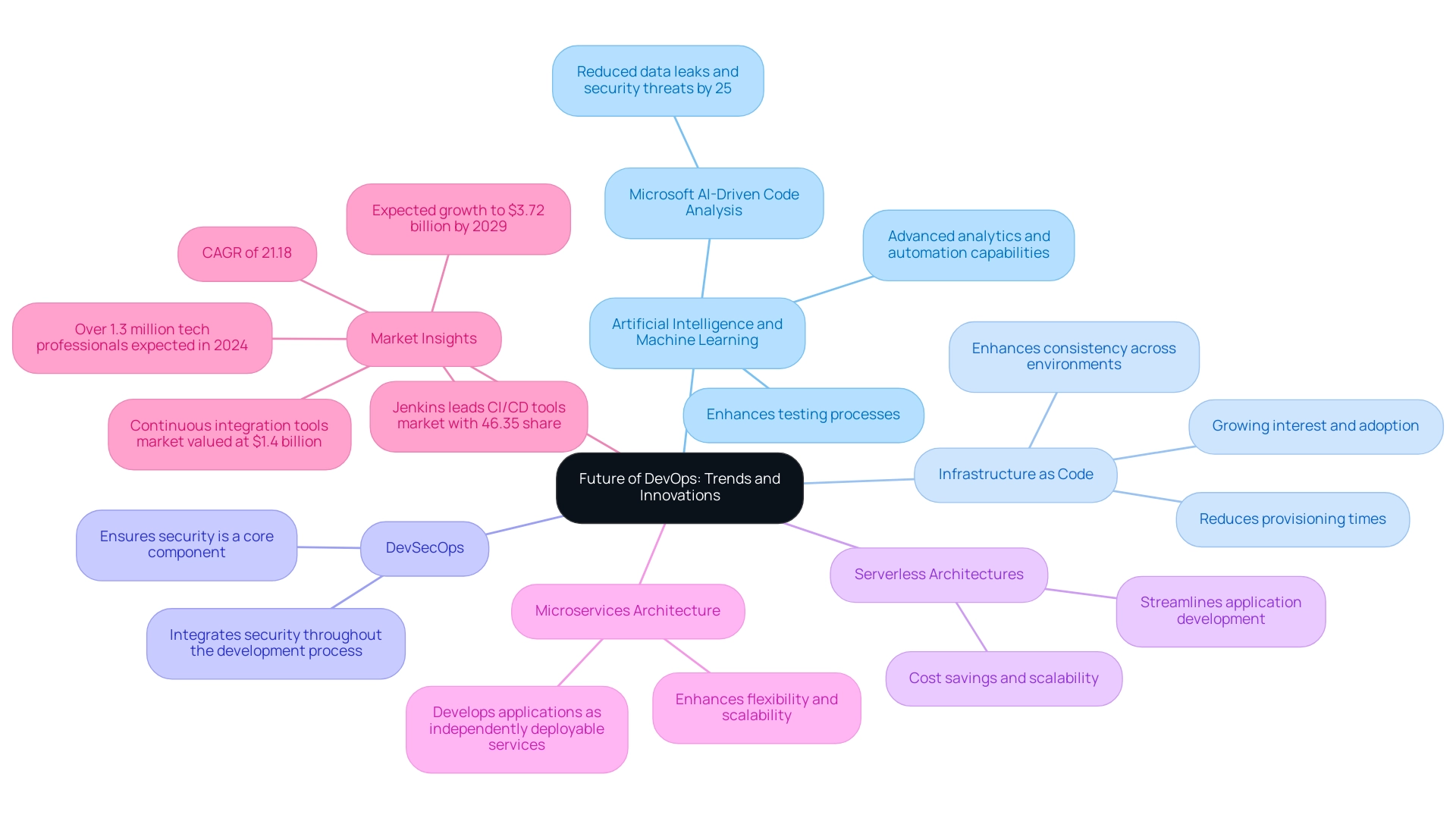
Conclusion
The exploration of DevOps reveals its critical role in modern software development, emphasizing the integration of development and operations to optimize efficiency and quality. By fostering a culture of collaboration, organizations can accelerate their software delivery while addressing pressing challenges in security and observability. As highlighted, the adoption of key tools and practices such as:
- CI/CD
- Configuration management
- Monitoring
not only enhances operational workflows but also aligns with the growing demand for skilled professionals in the field.
The benefits of adopting DevOps services are substantial, ranging from reduced time-to-market to improved software quality and customer satisfaction. Organizations that embrace this methodology can expect to see a transformative impact on their operational effectiveness, positioning themselves to thrive in an increasingly competitive landscape. However, the journey to successful DevOps implementation is not without its challenges, including:
- Cultural resistance
- Skill gaps
- The need for effective integration of tools
Looking ahead, the future of DevOps is set to be shaped by emerging trends such as:
- AI and machine learning
- Infrastructure as Code
- The integration of security practices throughout the development lifecycle
Staying abreast of these innovations will empower organizations to adapt their strategies and leverage new technologies to maintain a competitive edge. In summary, the strategic adoption of DevOps practices is essential for organizations aiming to enhance their capabilities and drive innovation in today’s fast-paced digital environment.




